Effects of Dust and Moisture Surface Contaminants on Automotive Radar Sensor Frequencies
Abstract
:1. Introduction
- We propose a quantitative measurement method for surface contamination caused by standardized dust and moisture combinations, utilizing a variety of analytical systems, including a 76–81 GHz radar, a 72–82 GHz automotive radome tester, and a 60–90 GHz vector network analyzer;
- The impact of surface contamination on radar signal characteristics, including signal attenuation, is quantitatively measured and analyzed, with an emphasis on the effects of moisture and standardized dust combinations;
- We demonstrate the impact of surface contamination on radar signal attenuation and its subsequent effect on target detection performance, with a focus on the quantitative measurement and analysis of how contaminants influence a radar’s ability to detect objects in a controlled environment.
2. Methods and Measurement Setup
2.1. Analytical Approach
2.2. Measurement Setup of Radome Tester
2.3. Measurement Setup of Vector Network Analyzer
2.4. Measurement Setup of Radar Target Simulator
3. Results and Discussion
3.1. Measurement Results of Water, Dust, and Mud Using Radome Tester
3.2. Measurement Results of Moisture and Dust Combination
3.2.1. Measurement Results Using VNA
3.2.2. Measurement Results Using RTS and Radar
4. Conclusions
Author Contributions
Funding
Institutional Review Board Statement
Informed Consent Statement
Data Availability Statement
Conflicts of Interest
Abbreviations
| AD | Autonomous driving |
| ADAS | Advanced Driver Assistance Systems |
| MUT | Material under test |
| RTS | Radar target simulator |
| VNA | Vector network analyzer |
References
- Rosique, F.; Navarro, P.J.; Fernández, C.; Padilla, A. A systematic review of perception system and simulators for autonomous vehicles research. Sensors 2019, 19, 648. [Google Scholar] [CrossRef] [PubMed]
- Mohammed, A.S.; Amamou, A.; Ayevide, F.K.; Kelouwani, S.; Agbossou, K.; Zioui, N. The perception system of intelligent ground vehicles in all weather conditions: A systematic literature review. Sensors 2020, 20, 6532. [Google Scholar] [CrossRef] [PubMed]
- Fayyad, J.; Jaradat, M.A.; Gruyer, D.; Najjaran, H. Deep learning sensor fusion for autonomous vehicle perception and localization: A review. Sensors 2020, 20, 4220. [Google Scholar] [CrossRef] [PubMed]
- Guastella, D.C.; Muscato, G. Learning-based methods of perception and navigation for ground vehicles in unstructured environments: A review. Sensors 2020, 21, 73. [Google Scholar] [CrossRef] [PubMed]
- Dickmann, J.; Klappstein, J.; Hahn, M.; Appenrodt, N.; Bloecher, H.L.; Werber, K.; Sailer, A. Automotive radar the key technology for autonomous driving: From detection and ranging to environmental understanding. In Proceedings of the 2016 IEEE Radar Conference (RadarConf), Philadelphia, PA, USA, 2–6 May 2016; pp. 1–6. [Google Scholar]
- Venon, A.; Dupuis, Y.; Vasseur, P.; Merriaux, P. Millimeter wave fmcw radars for perception, recognition and localization in automotive applications: A survey. IEEE Trans. Intell. Veh. 2022, 7, 533–555. [Google Scholar]
- Ehrnsperger, M.G.; Siart, U.; Moosbühler, M.; Daporta, E.; Eibert, T.F. Signal degradation through sediments on safety-critical radar sensors. Adv. Radio Sci. 2019, 17, 91–100. [Google Scholar] [CrossRef]
- Norouzian, F.; Xiao, Y.; Gashinova, M. The Effect of Weather on the Performance of mm-Wave and Sub-THz Automotive Radar; IET: London, UK, 2024. [Google Scholar]
- Li, X.; Cheng, X.; Ju, X.; Peng, Y.; Hu, J.; Li, J. Optimization on the Polarization and Waveform of Radar for Better Target Detection Performance under Rainy Condition. Remote Sens. 2024, 16, 2557. [Google Scholar] [CrossRef]
- Norouzian, F.; Du, R.; Hoare, E.G.; Gardner, P.; Constantinou, C.; Cherniakov, M.; Gashinova, M. Low-THz transmission through water-containing contaminants on antenna radome. IEEE Trans. Terahertz Sci. Technol. 2017, 8, 63–75. [Google Scholar] [CrossRef]
- Zhang, Y.; Carballo, A.; Yang, H.; Takeda, K. Perception and sensing for autonomous vehicles under adverse weather conditions: A survey. ISPRS J. Photogramm. Remote Sens. 2023, 196, 146–177. [Google Scholar]
- Li, H.; Bamminger, N.; Magosi, Z.F.; Feichtinger, C.; Zhao, Y.; Mihalj, T.; Orucevic, F.; Eichberger, A. The effect of rainfall and illumination on automotive sensors detection performance. Sustainability 2023, 15, 7260. [Google Scholar] [CrossRef]
- Arage, A.; Steffens, W.M.; Kuehnle, G.; Jakoby, R. Effects of water and ice layer on automotive radar. In Proceedings of the German Microwave Conference Citeseer, Karlsruhe, Germany, 28–30 March 2006. [Google Scholar]
- Expósito, I.; Chin, I.; García Sánchez, M.; Cuinas, I.; Verhaevert, J. Car bumper effects in ADAS sensors at automotive radar frequencies. Sensors 2023, 23, 8113. [Google Scholar] [CrossRef] [PubMed]
- Gaylard, A.P.; Kirwan, K.; Lockerby, D.A. Surface contamination of cars: A review. Proc. Inst. Mech. Eng. Part D J. Automob. Eng. 2017, 231, 1160–1176. [Google Scholar] [CrossRef]
- Eidevåg, T.; Eng, M.; Kallin, D.; Casselgren, J.; Bharadhwaj, Y.; Narahari, T.S.B.; Rasmuson, A. Snow Contamination of Simplified Automotive Bluff Bodies: A Comparison Between Wind Tunnel Experiments and Numerical Modeling. SAE Int. J. Adv. Curr. Pract. Mobil. 2022, 4, 2120–2134. [Google Scholar] [CrossRef]
- Norouzian, F.; Du, R.; Gashinova, M.; Hoare, E.; Constantinou, C.; Lancaster, M.; Gardner, P.; Cherniakov, M. Signal reduction due to radome contamination in low-THz automotive radar. In Proceedings of the 2016 IEEE Radar Conference (RadarConf), Philadelphia, PA, USA, 2–6 May 2016; pp. 1–4. [Google Scholar]
- Du, R.; Norouzian, F.; Marchetti, E.; Willetts, B.; Gashinova, M.; Cherniakov, M. Characterisation of attenuation by sand in low-THz band. In Proceedings of the 2017 IEEE Radar Conference (RadarConf), Seattle, WA, USA, 8–12 May 2017; pp. 0294–0297. [Google Scholar]
- Bouquin, P.; Bourreau, D.; Peden, A. Millimeter and Sub-millimeter Wave Transmission Through a Radome Covered by Water: The Impact of the Shape of Water. J. Infrared Millim. Terahertz Waves 2024, 45, 265–279. [Google Scholar] [CrossRef]
- Norouzian, F.; Du, R.; Marchetti, E.; Gashinova, M.; Hoare, E.; Constantinou, C.; Gardner, P.; Cherniakov, M. Low-THz transmission through liquid contaminants on antenna radome. In Proceedings of the 12th European Conference on Antennas and Propagation (EuCAP 2018), London, UK, 9–13 April 2018. [Google Scholar]
- Norouzian, F.; Du, R.; Marchetti, E.; Gashinova, M.; Hoare, E.; Constantinou, C.; Gardner, P.; Cherniakov, M. Transmission through uniform layer of ice at low-THz frequencies. In Proceedings of the 2017 European Radar Conference (EURAD), Nuremberg, Germany, 11–13 October 2017; pp. 211–214. [Google Scholar]
- Schlager, B.; Goelles, T.; Muckenhuber, S.; Watzenig, D. Contaminations on LiDAR sensor covers: Performance degradation including fault detection and modeling as potential applications. IEEE Open J. Intell. Transp. Syst. 2022, 3, 738–747. [Google Scholar]
- Trierweiler, M.; Caldelas, P.; Gröninger, G.; Peterseim, T.; Neumann, C. Influence of sensor blockage on automotive LiDAR systems. In Proceedings of the 2019 IEEE SENSORS, Montreal, QC, Canada, 27–30 October 2019; pp. 1–4. [Google Scholar]
- Schlager, B.; Goelles, T.; Watzenig, D. Effects of sensor cover damages on point clouds of automotive lidar. In Proceedings of the 2021 IEEE Sensors, Virtually, 31 October–4 November 2021; pp. 1–4. [Google Scholar]
- Jati, G.; Molan, M.; Barchi, F.; Bartolini, A.; Mercurio, G.; Acquaviva, A. LIDAROC: Realistic LiDAR Cover Contamination Dataset for Enhancing Autonomous Vehicle Perception Reliability. IEEE Sens. Lett. 2024, 8, 1502404. [Google Scholar] [CrossRef]
- Gonçalves, F.J.F.; Pinto, A.G.; Mesquita, R.C.; Silva, E.J.; Brancaccio, A. Free-space materials characterization by reflection and transmission measurements using frequency-by-frequency and multi-frequency algorithms. Electronics 2018, 7, 260. [Google Scholar] [CrossRef]
- R&S® QAR50 Quality Automotive Radome Tester. 2025. Available online: https://www.rohde-schwarz.com/products/test-and-measurement/radome-tester/rs-qar50-quality-automotive-radome-tester_63493-1138625.html?change_c=true (accessed on 18 February 2025).
- R&S® ZNA Vector Network Analyzers. 2025. Available online: https://www.rohde-schwarz.com/fi/products/test-and-measurement/network-analyzers/rs-zna-vector-network-analyzers_63493-551810.html (accessed on 18 February 2025).
- R&S® ZCxxx Millimeterwave Converters. 2025. Available online: https://www.rohde-schwarz.com/ae/products/test-and-measurement/converters/rs-zcxxx-millimeterwave-converters_63493-133190.html (accessed on 18 February 2025).
- R&S® AREG800A Automotive Radar Echo Generator. 2025. Available online: https://www.rohde-schwarz.com/products/test-and-measurement/echo-generators/rs-areg800a-automotive-radar-echo-generator_63493-1044352.html (accessed on 18 February 2025).
- AWR1843BOOST, Single-Chip 76-GHz to 81-GHz Automotive Radar Sensor Evaluation Module. 2025. Available online: https://www.ti.com/tool/AWR1843BOOST (accessed on 18 February 2025).
- ISO 12103-1; Road Vehicles—Test Contaminants for Filter Evaluation—Part 1: Arizona Test Dust. ISO: Geneva, Switzerland, 2016.
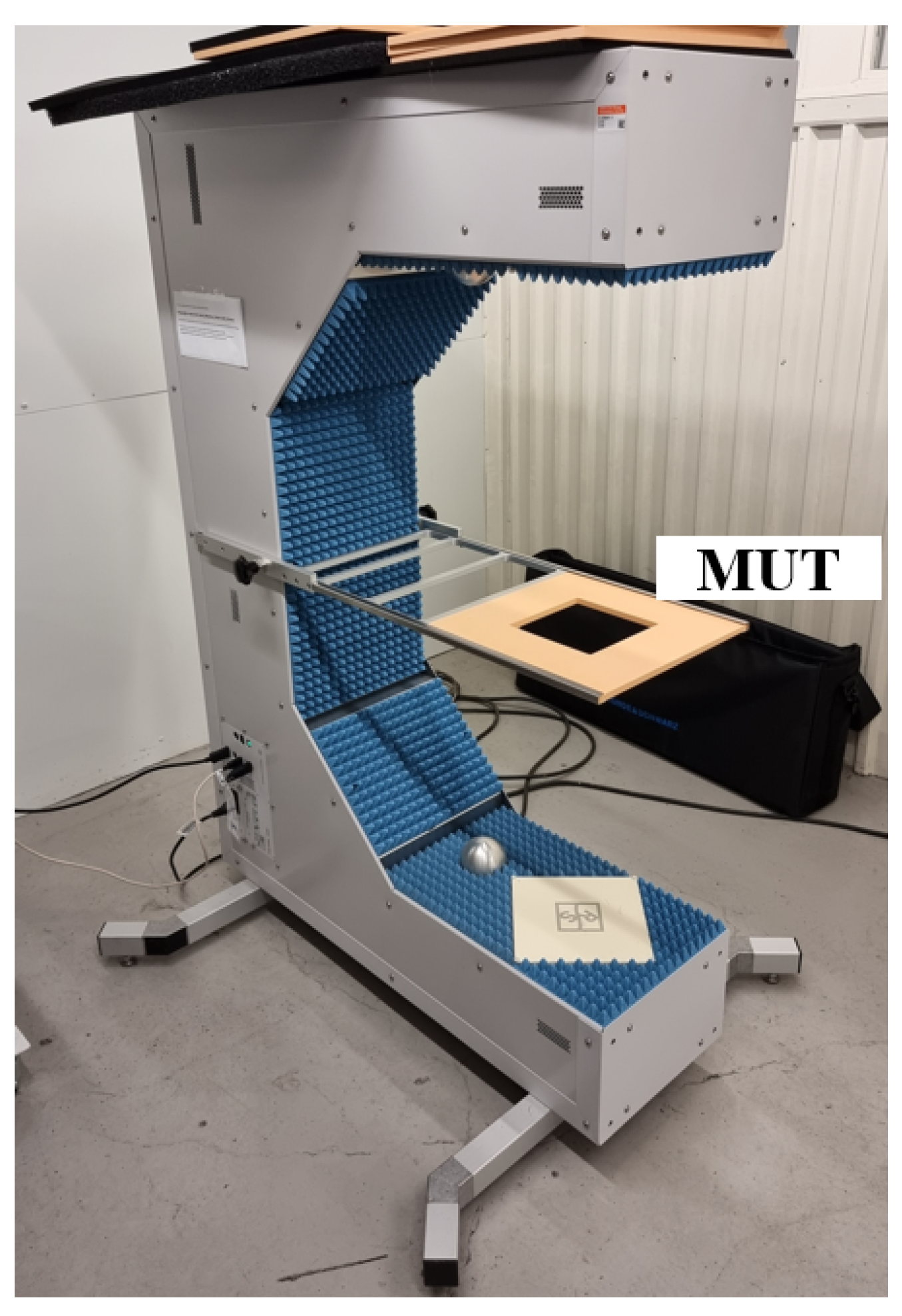
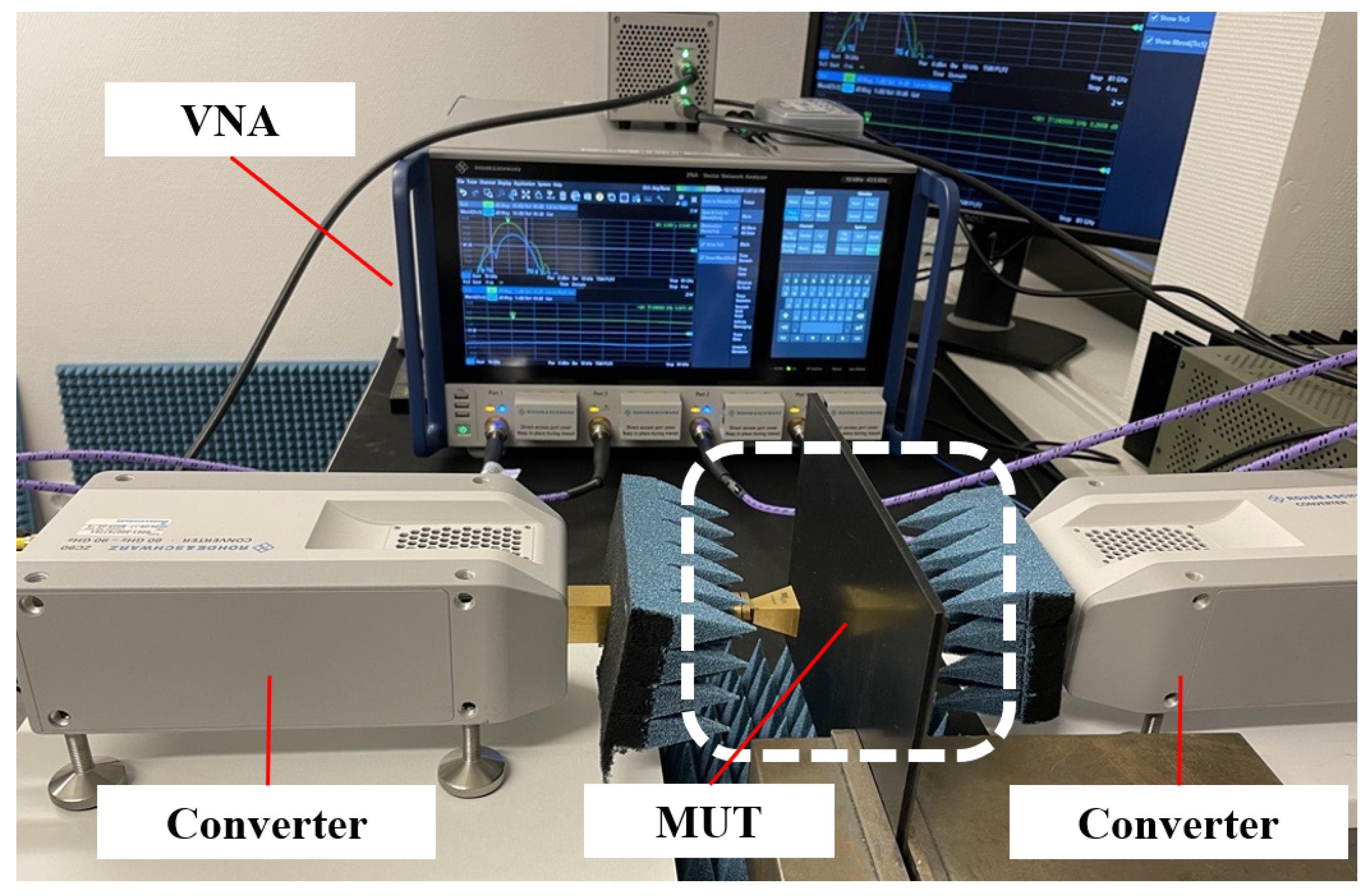

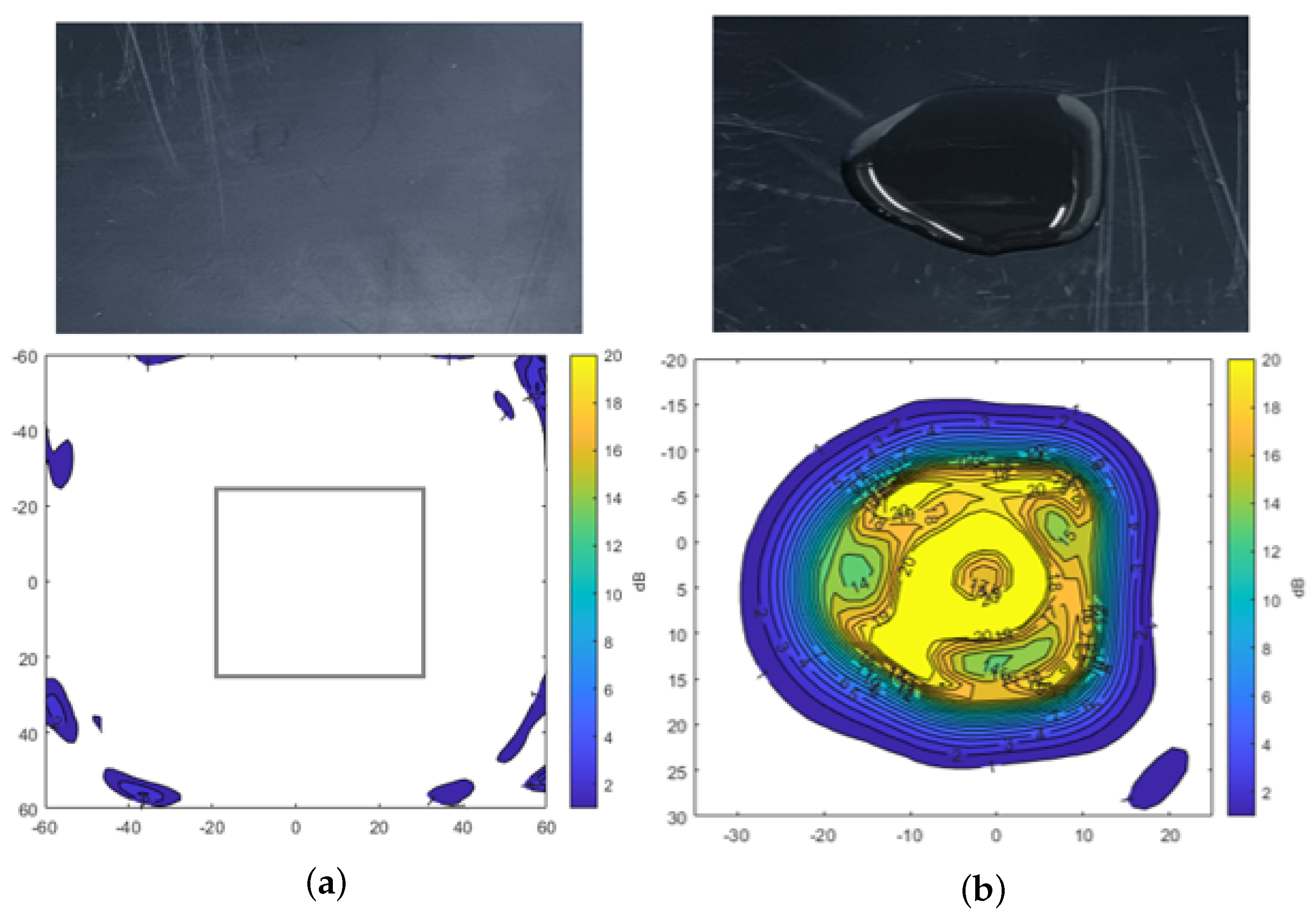


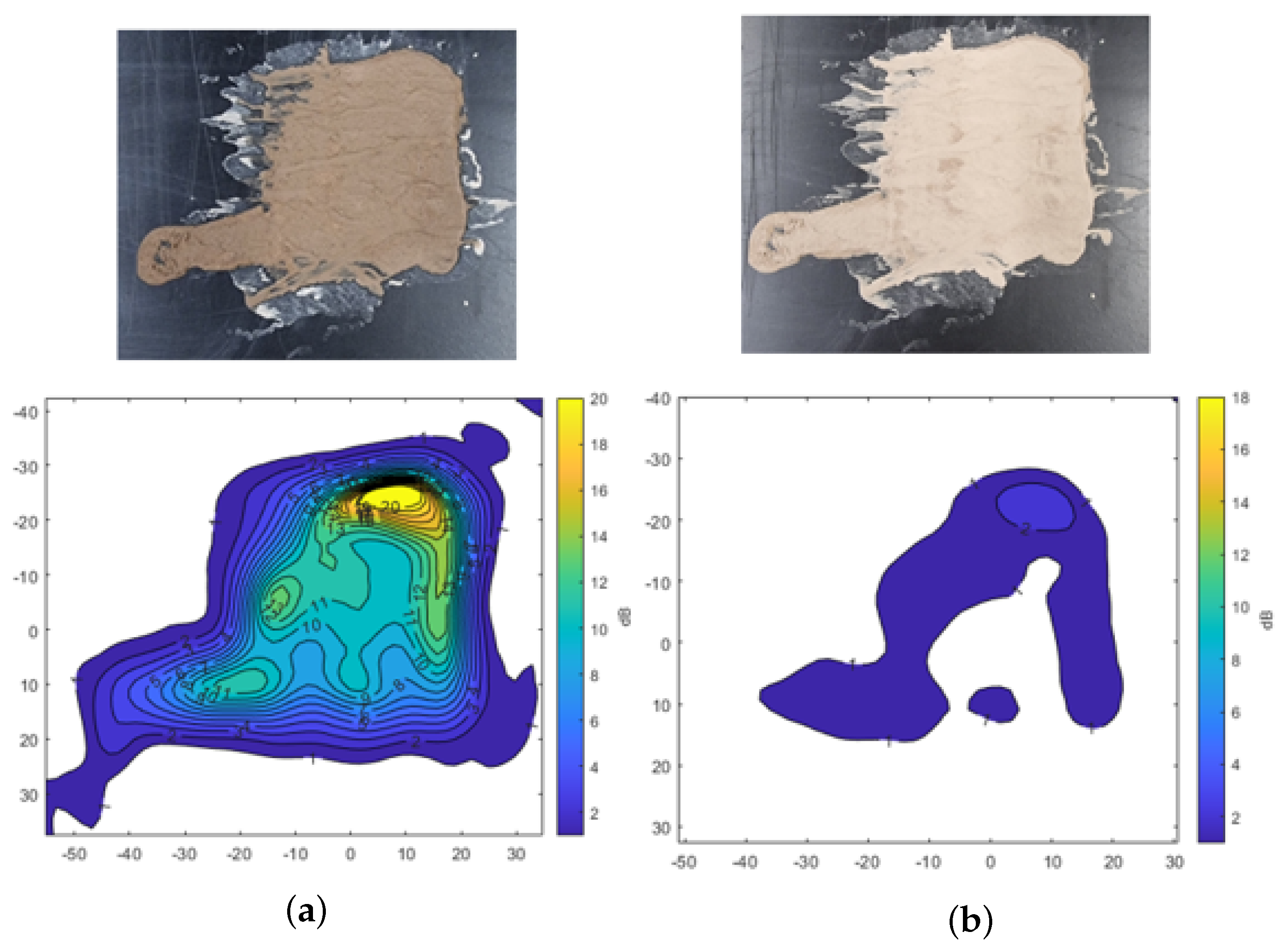
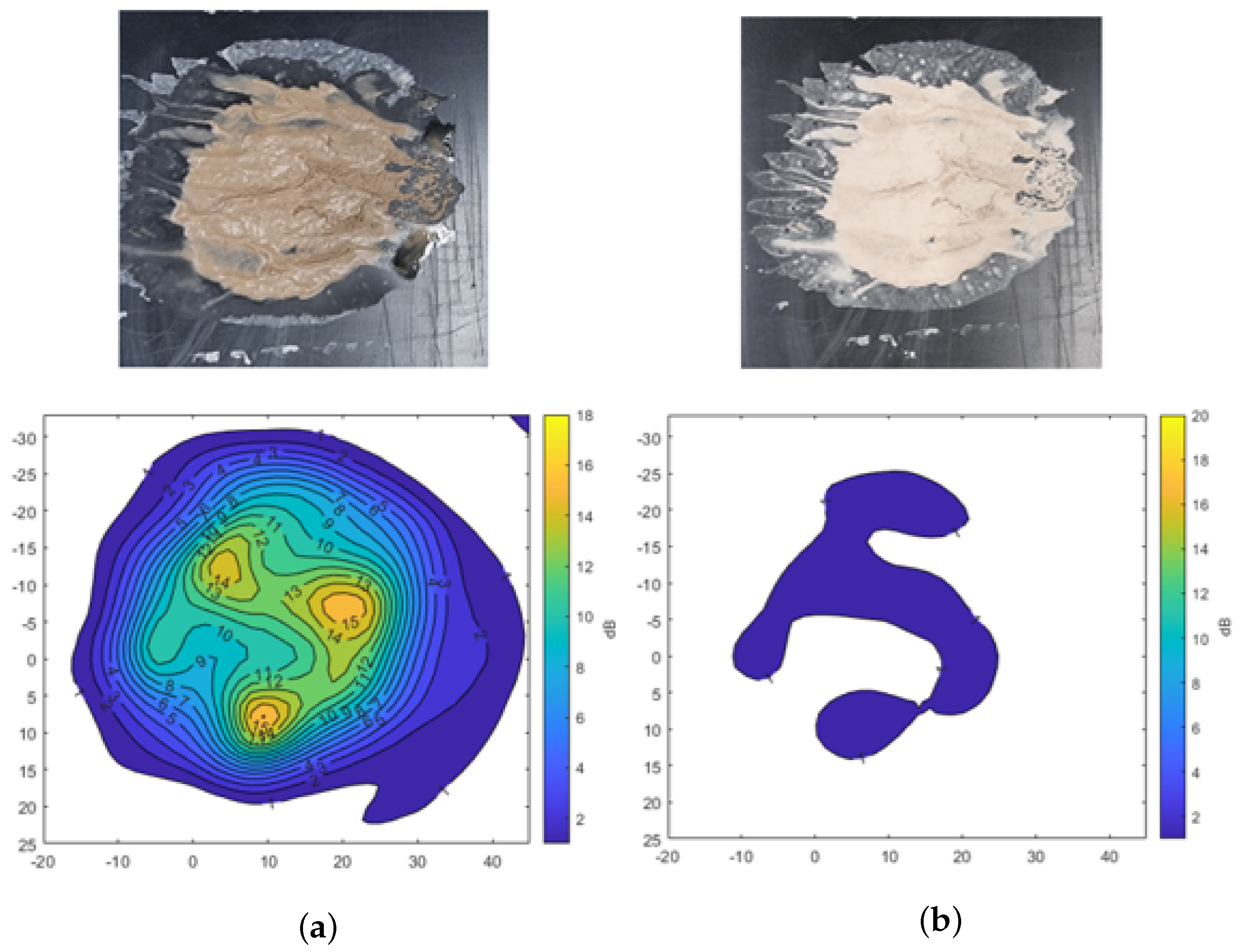

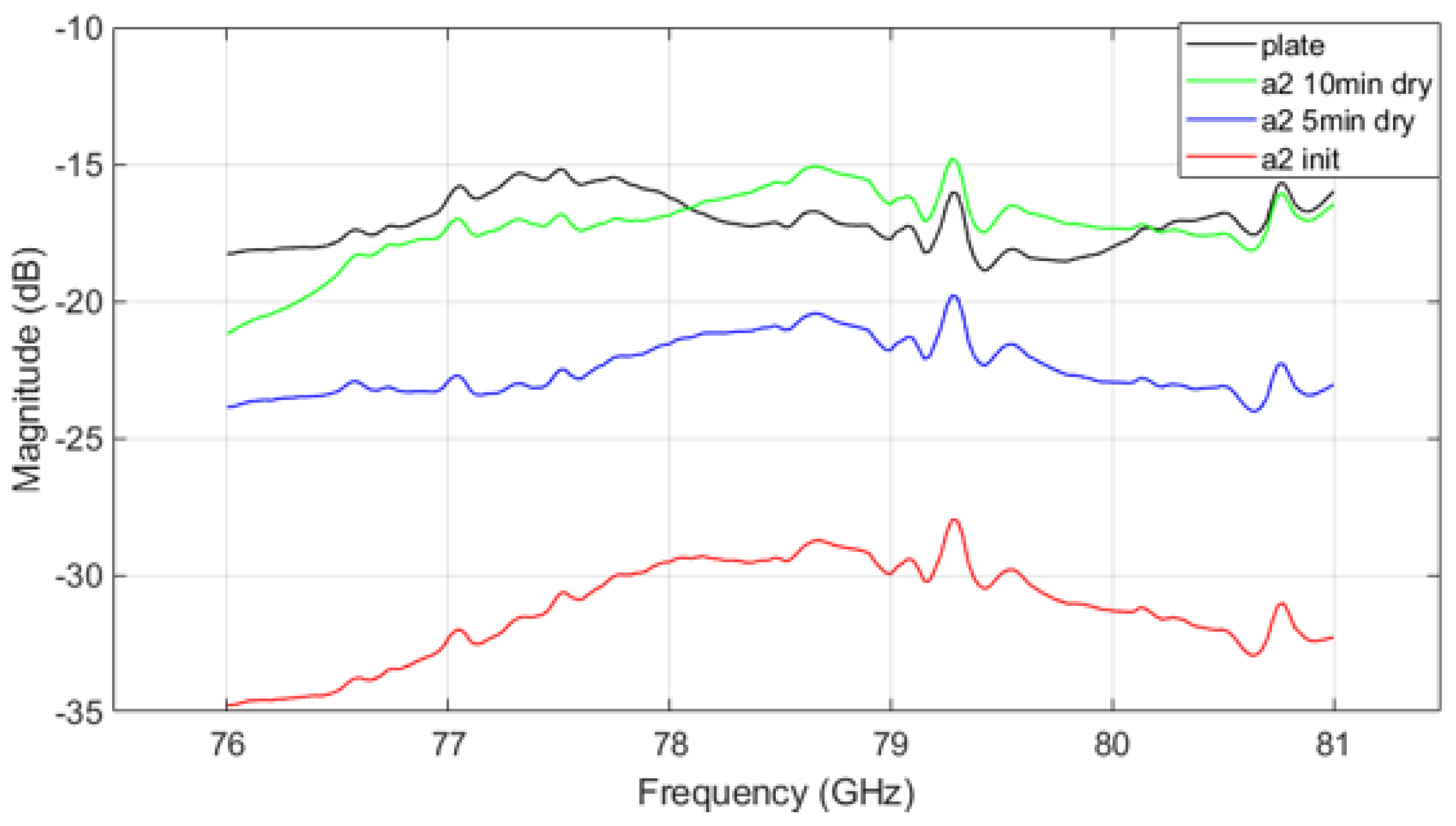






| Mud Type | Conditions | Relative Attenuation at Each Frequency (dB) | |||||
|---|---|---|---|---|---|---|---|
| 76 Hz | 77 Hz | 78 Hz | 79 Hz | 80 Hz | 81 Hz | ||
| A2 fine mud | Init | −16.50 | −16.09 | −13.29 | −12.23 | −13.28 | −16.28 |
| 5 min Dry | −5.61 | −6.70 | −5.33 | −4.06 | −4.93 | −7.05 | |
| 10 min Dry | −2.91 | −1.02 | −0.64 | 1.26 | 0.68 | −0.46 | |
| A4 coarse mud | Init | −11.30 | −11.1 | −8.88 | −8.44 | −9.28 | −11.21 |
| 5 min Dry | −4.26 | −1.57 | −2.75 | −1.41 | −1.56 | −2.20 | |
| 10 min Dry | −1.38 | 1.17 | −1.10 | 0.45 | 1.30 | 1.82 | |
| A2&A4 mixed mud | Init | −15.46 | −15.02 | −12.03 | −11.69 | −12.28 | −14.03 |
| 5 min Dry | −5.01 | −6.04 | −5.03 | −3.55 | −3.76 | −6.20 | |
| 10 min Dry | −1.93 | 0.99 | −1.54 | 0.15 | 0.71 | 1.05 | |
| Mud Type | Conditions | Relative Power at Each Frequency (dB) | ||||
|---|---|---|---|---|---|---|
| 76 Hz | 77 Hz | 78 Hz | 79 Hz | 80 Hz | ||
| A2 fine mud | Plate | 57.4779 | 58.3246 | 57.4779 | 60.7939 | 51.7866 |
| Init | 47.0124 | 41.7914 | 43.7905 | 41.7444 | 42.0266 | |
| 5 min Dry | 54.7969 | 47.4593 | 49.1055 | 49.6464 | 42.6616 | |
| 10 min Dry | 54.0913 | 51.3162 | 51.8806 | 56.0198 | 55.8787 | |
| A4 coarse mud | Plate | 57.4779 | 58.3246 | 57.4779 | 60.7939 | 51.7866 |
| Init | 42.9673 | 44.9193 | 46.0482 | 46.8243 | 47.0124 | |
| 5 min Dry | 46.3539 | 52.4686 | 51.9982 | 54.5617 | 53.4799 | |
| 10 min Dry | 47.1065 | 52.6097 | 55.5730 | 55.7611 | 58.2070 | |
| A2&A4 mixed mud | Plate | 57.4779 | 58.3246 | 57.4779 | 60.7939 | 51.7866 |
| Init | 42.3088 | 43.0144 | 45.0604 | 44.2843 | 43.814 | |
| 5 min Dry | 46.7302 | 50.2344 | 54.5147 | 53.5504 | 46.2834 | |
| 10 min Dry | 49.8581 | 53.3858 | 58.9831 | 60.6528 | 51.3868 | |
Disclaimer/Publisher’s Note: The statements, opinions and data contained in all publications are solely those of the individual author(s) and contributor(s) and not of MDPI and/or the editor(s). MDPI and/or the editor(s) disclaim responsibility for any injury to people or property resulting from any ideas, methods, instructions or products referred to in the content. |
© 2025 by the authors. Licensee MDPI, Basel, Switzerland. This article is an open access article distributed under the terms and conditions of the Creative Commons Attribution (CC BY) license (https://creativecommons.org/licenses/by/4.0/).
Share and Cite
Kang, J.; Hamidi, O.; Vanäs, K.; Eidevåg, T.; Nilsson, E.; Friel, R. Effects of Dust and Moisture Surface Contaminants on Automotive Radar Sensor Frequencies. Sensors 2025, 25, 2192. https://doi.org/10.3390/s25072192
Kang J, Hamidi O, Vanäs K, Eidevåg T, Nilsson E, Friel R. Effects of Dust and Moisture Surface Contaminants on Automotive Radar Sensor Frequencies. Sensors. 2025; 25(7):2192. https://doi.org/10.3390/s25072192
Chicago/Turabian StyleKang, Jeongmin, Oskar Hamidi, Karl Vanäs, Tobias Eidevåg, Emil Nilsson, and Ross Friel. 2025. "Effects of Dust and Moisture Surface Contaminants on Automotive Radar Sensor Frequencies" Sensors 25, no. 7: 2192. https://doi.org/10.3390/s25072192
APA StyleKang, J., Hamidi, O., Vanäs, K., Eidevåg, T., Nilsson, E., & Friel, R. (2025). Effects of Dust and Moisture Surface Contaminants on Automotive Radar Sensor Frequencies. Sensors, 25(7), 2192. https://doi.org/10.3390/s25072192






